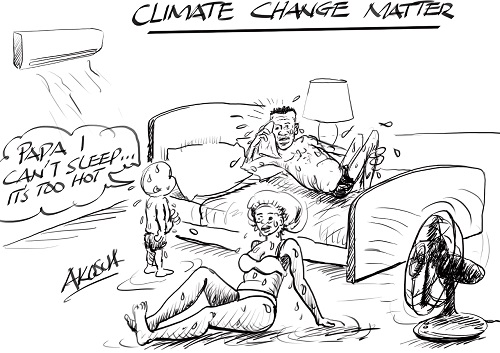

Scientists have suggested unabated carbon emissions could lead to huge global changes.
Hey there! Nice to meet you. I'm from the future.
I live in the 26th century, which is deep in the Anthropocene epoch — a time when people are officially the greatest driver of climate change on Earth, and have been for awhile.
Things really seemed to pick up steam about 500 years earlier, after a US president backed out of an international agreement to dramatically curb carbon emissions.
It's a dubious honor if you could see the planet from five centuries later. These are the highlights — if you can call them that.
This is an updated version of a post by Sarah Kramer.
Let's start with the year 2100, when things really started getting hot — on average, almost 4 degrees Fahrenheit hotter than in 2017.
Source: National Oceanic and Atmospheric Administration
Parts of Africa, South America, and India often averaged over 110 degrees during the summer, killing thousands of people to each year from heat-related causes.
Source: US Global Research Program
Glaciers in High Mountain Asia — an area that included the Himalayas — shrank to 30% of their 21st-century size.
Source: European Geosciences Union
The loss of that stable source of melt water, coupled with huge droughts and continued population growth, meant that water resources in Asia all but collapsed.
Source: Tech Insider
Huge glaciers in the European Alps completely vanished.
Source: Reuters
The oceans became hotter and more acidic. Your grandkids never got to see the Great Barrier Reef, or any living coral reef outside an aquarium.
Source: CNN
Sea levels rose 3 feet and hundreds of thousands of people were displaced. The island nations of Tuvalu, Kiribati, and the Marshall Islands became uninhabitable.
Source: The Brookings Institute
Millions of coastline-dwellers became climate refugees — including 13 million Americans. Disney World and Disney Land both disappeared underwater.
Source: Huffington Post
During the 22nd century, the world's population reached 9.5 billion people. The strain on resources — food, water, and energy — sparked a new generation of conflicts.
Source: United Nations Department of Economic and Social Affairs
The good news is that we made it to Mars. The European Union, Russia, China, and the US managed to send the first multinational team in 2050.
Source: NASA
But after a 150 years of successful Mars colonization, the most powerful solar storm ever recorded hit the Earth and Mars. Our electrical grid failed, communications went down, and — by the time we restored everything years later — the colony had gone silent.
Sources: Business Insider, The New York Times
In the 23rd century, we reached the zenith of the sixth mass extinction. Amphibians were the hardest-hit. We lost over 1,000 species of frogs, newts, salamanders, and more.
Source: Nature
But they weren't the only ones. Thousands of species of birds, mammals, and insects were wiped from the face of the Earth.
Sometime between 2200 and 2300, things got really bad. The Greenland Ice Sheet collapsed and melted, causing sea levels to rise 20 feet.
Source: Yale University
The Middle East, already wracked by ethnic and resource-driven conflict, became inhospitable. Canada began a massive resettlement plan, opening up the former tundra to climate refugees.
South America and Africa — the world's most fertile regions three centuries ago — lost a fifth of the land suitable for farming. Farming moved to the US, China, and Russia, which all gained arable land.
Source: Environmental Research Letters
In the 24th century, Mars finally got back in touch with us. But with 11 billion people on Earth, bringing the colonists back was not an option.
Source: United Nations Department of Economic and Social Affairs
But they weren’t interested in coming back to our crowded, resource-drained rock, anyway. They just needed a larger gene pool. Settlement missions started back up again.
Source: Business Insider
Without the pressure of an ice sheet, fault lines all over Greenland’s crust came loose. Earthquakes and tsunamis battered the North Atlantic for years.
Source: The Guardian
At the end of the 24th century, Antarctica's Thwaites Glacier receded past the continental shelf that surrounds it, speeding up its already-rapid collapse.
Source: National Geographic
And by the end of the 25th century, the West Antarctic Ice Sheet finally collapsed after years of slowly melting. Sea levels rose again, this time by another 30 feet.
Source: Science
There's more to come, though. The effects of unmitigated emissions will continue far beyond my lifetime in 2517, possibly for thousands of years.
Source: Nature
It didn't have to be this way. Limiting global warming to 2.7 degrees Fahrenheit wouldn't have solved everything, but it could have avoided a tipping point that claimed millions of lives and displaced billions more.
Sources: Business Insider, Nature, The Guardian
Scientists have suggested unabated carbon emissions could lead to huge global changes. Read Full Story
























Facebook
Twitter
Pinterest
Instagram
Google+
YouTube
LinkedIn
RSS